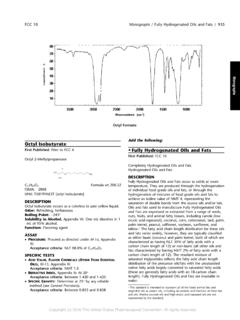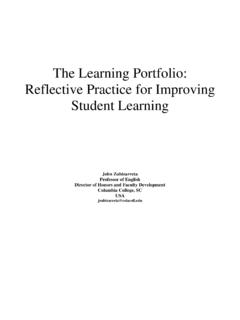Transcription of Kill Step Validation Model for Bakery Applications
1 Kill Step Validation Model for Bakery Applications Brian Strouts AIB International Outline: q Introduction q Kill-Step Validation Gen-1: Foundational research project: Hamburger bun kill-step Validation research Baking Process Kill-Step Calculator q Kill-Step Validation Gen-2: q Expected outcomes q Approximately 2,800 commercial bakeries and 6,000 retail bakeries operate in the , with a market value of nearly $30 billion/ year (Hussain 2014). q The baking industry comparatively has a very safe record for the production of shelf stable processed foods q Microbiological spoilage is often the major factor limiting the shelf life of Bakery products leading to huge economic losses (Smith et al.)
2 2010) q Although not directly linked to production practices, there were 4,200 illnesses associated with Bakery products reported in the between 1998 and 2011 (CSPI 2009) Introduction Introduction q The presence of Salmonella spp. in Bakery ingredients and products could create a public health risk if the product is improperly baked q Research findings revealed that Salmonella can survive in adverse conditions ( , low moisture foods) for a long time (Gruzdev et al. 2011 and Eglezos 2010) q Pathogens such as Salmonella spp. can be introduced into Bakery products through a wide range of ingredients such as egg (Board 1969; FSIS 1998), milk products (El-Gazzar et al.
3 1992; Ahmad et al. 2000), flour (Richter et al. 1993; Dack 1961), milk chocolate (D Aoust 1977), coconut (Goepfert 1980), peanut butter (Scheil et al. 1998), fruit (Golden et al. 1993), spices (Hara-Kudo et al. 2000) and yeast flavorings (Joseph et al. 1991) Bakery Products: Food Safety Challenges? Bakery Products: Food Safety Challenges q Although most Bakery products undergo a putative kill step at the point of production, such as baking or cooking, there lacks published scientific proof or Validation research q FDA-FSMA regulatory requirement requires Validation and verification of kill-step q A preemptive scientific evaluation providing documentary evidence that a particular process is capable of consistently delivering a product.
4 Meeting its pre-determined specifications q A collection of scientific evidence Validation The The q What would constitute Validation ? ( (b)(2)): The proposed rule would require that the Validation of preventive controls include collecting and evaluating scientific and technical information or, when such information is not available or is insufficient, conducting studies to determine whether the preventive controls, when properly implemented, will effectively control the hazards that are reasonably likely to occur q Must be performed (or overseen) by a preventive controls qualified individual.
5 Or q Within 90 calendar days after production of the applicable food first begins; or q Whenever a change to a control measure occurs; or q Whenever a reanalysis of the food safety plan reveals the need to do so; Key FSMA Validation Requirement Key FSMA Validation Requirement q We used hamburger bun manufacturing as the Model to develop a scientific Validation protocol, as it is one of the most popular Bakery products consumed in the and in Canada. q This is the first study of its kind involving validating a Bakery product with baking as a kill step for Salmonella spp.
6 , E. faecium and Saccharomyces cerevisiae Hamburger Bun Kill-Step Validation Research Hamburger Bun Validation Research Research Collaborators Research Collaborators To validate a simulated commercial baking process for hamburger buns to destroy Salmonella spp., and to determine the appropriateness of using non-pathogenic surrogates (Enterococcus faecium ATCC 8459 or Saccharomyces cerevisiae) for in-plant process Validation studies Goal Goal 1. Validate the baking process as a kill step in reducing Salmonella spp. during the manufacture of hamburger buns 2.
7 Validate the baking step s effectiveness in reducing S. cerevisiae and E. faecium to determine appropriateness of utilizing non-pathogenic surrogate for industry Validation and process verification purposes, and 3. Determine the heat resistance viz, D-value, and z-value of Salmonella spp., S. cerevisiae and E. faecium in hamburger bun dough Research Objectives Research Objectives q Salmonella serovars: Salmonella enterica serovar Typhimurium (ATCC 14028) Salmonella enterica serovar Newport (ATCC 6962) Salmonella enterica serovar Senftenberg (ATCC 43845) q Enterococcus: Enterococcus faecium (ATCC 8459) q Yeast.
8 Saccharomyces cerevisiae (Compressed Yeast) Microorganisms Used in this Research Microorganisms Used q Two trays ( cm x cm x 14 cm) of flour containing 400 g each were mist inoculated with 4 mL of the target culture to achieve 6-7 log10 CFU/g q This inoculation procedure was conducted within a Class II Type A2 biosafety cabinet q After 5 min, trays of inoculated flour were placed into a 37 C incubator until they returned to pre-inoculation dry weight q Inoculated flour was stored at ambient temperature for 36-48 h prior to use q Final target bacterial concentrations of the flour were determined immediately prior to initiation of mixing the dough Flour Inoculation Flour Inoculation Salmonella spp.
9 Enterococcus spp. 14362578 Hamburger bun kill-step Validation research Overview Figure 1. Survival population of Salmonella serovars, Enterococcus faecium and Saccharomyces cerevisiae, in hamburger buns during baking at 218 C (using selective media) DL Results Results DL and Saccharomyces cerevisiae, in hamburger buns during baking at 218 C (using injury recover media) Survival population of Salmonella serovars, Enterococcus faecium and Saccharomyces cerevisiae, in hamburger buns during baking at 218 C Microbial kinetics study Table 1. D-values (min) and z-values ( C) of a 3-strain Salmonella spp.
10 Cocktail, and Enterococcus faecium ATCC 8459 in hamburger bun dough Salmonella spp. E. faecium BHI/XLDa XLDb BHI/mEAc mEAd Temperature ( C) 55 0 58 61 z-value a Injury-recovery media, Brain Heart Infusion (BHI) agar with Xylose Lysine Desoxycholate (XLD) agar overlay; b Selective medium, XLD agar; c Injury-recovery media, BHI agar with m-Enterococcus (mE) agar overlay; d Selective medium, mE agar. Salmonella cocktail: S. enterica serovar Typhimurium (ATCC 14028); S.






